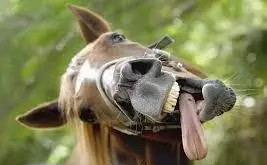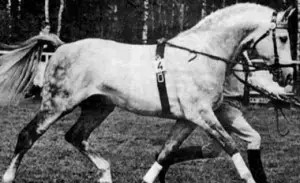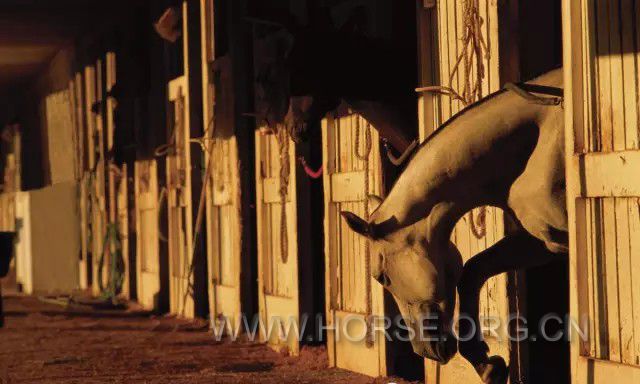马上注册,结交更多马友,享用更多功能
您需要 登录 才可以下载或查看,没有账号?立即注册
x

伸出舌头,玩舌头(Tongue Lolling)
This is another oral stereotypical behavior that is seen in horses who are not coping with their living conditions and general environment. This one can occur when the horse is ridden as well as when he is in his stable. In contrast to the other oral behaviors it does not cause harm to the horses teeth or digestive system. It is considered a very bad habit in most showing or competition situations and in dressage is a problem indicative of tension in the horses body and unhappiness. As for the previous vices, the treatment is to give the horse more time on pasture, equine companionship and greater amounts of fibre in his diet may help too. Often people use tongue ties, or very tight nosebands forcing the horses mouth closed, this is obviously not a cure.
这是另外一种口部刻板行为,通常出现在那些不能适应生活环境的马身上。该行为不论是在被骑乘过程中,还是马呆在马厩时,都可能出现。与别的口部刻板行为相比,伸出舌头并不会损坏马的牙齿和消化系统,但是在选美(showing)和一些比赛中,被视为不良习惯;在盛装舞步中,这是个问题,被视为是马的身体紧绷、不开心。针对我们前面讨论过的那些恶习, 治疗方案是让马在放牧场的时间更长,有同伴马陪伴它们,在它们的日粮中增加更多的粗纤维或许也会有所帮助。针对马伸出舌头,玩舌头(Tongue Lolling)的情况,通常人们会绑舌头的绳子,或非常紧的鼻羁(nosebands)强迫马闭紧嘴巴,而这显然无法治愈马。
Locomotory Stereotypical Behaviours:Weaving
运动刻板行为:摇动
A horse that weaves stands with its head over a stable door and constantly moves from side to side. This stable vice is caused by the stress of confinement in a stall. Horses in the wild run and graze for a good part of their day. Weaving is a “Displacement Behavior” for the movement used while grazing. It also satisfies a horse's need for images moving across the eye similar to grazing. Research indicates that weaving decreases when stalls have windows because it provides visual contact with other horses. Horses usually stop weaving when turned out in a paddock.
“摇动”(weaving)的马,通常把自己的头悬在马厩门上,不断的从一边移动到另一边。这种在马厩中恶习,是由于马被局限在马厩中产生的应激反应而导致的——毕竟,在草原自由的奔跑,吃草,是马的天性。摇动(weaving)是一阵“转位行为”——该动作被用于“grazing”(在放牧场走走停停吃草)时。研究显示,在马厩中增加窗户,能减轻摇动(weaving)的症状,因为这些马和别的马能有视觉联络。让这些马到放牧场自由跑的时候,通常情况下它们会停止摇动(weaving)的行为。
My husbands experience with a weaving horse leads to a rather funny story. He purchased a very famous Premium A stallion named Callaghan in Sweden. Calle was a very well bred horse, an amazing pedigree and my husband was very lucky to get the opportunity to purchase the stallion. He knew Calle had the weaving problem but, the horses bloodline was so good that my husband decided that he could take the chance and manage the problem.
我的丈夫曾有有过一匹有摇动(weaving)行为的马,经历了一番有趣的体验。他购买了瑞典的Premium A(最顶级)种公马,著名的Callaghan。Callaghan是一匹血统非常好的马,能有机会买到它,我的丈夫实在非常幸运。虽然购买前他就知道这匹马有摇动(weaving)的问题,然而,考虑到它的血统实在太好,我丈夫觉得这值得一试,通过管理处理这个问题。

So, he drove to the farm in his rental car (a Volvo) with a small horse trailer and loaded Calle onto the trailer, paid the owner and then had to drive all the way from Sweden to Frankfurt, Germany. A very long drive but, he had to get Calle to Frankfurt quickly to catch the plane with the other 30 young fillies and colts he had purchased. Calle weaved in the horse trailer back and forward for the whole trip which made for a nervous drive as the trailer swayed from side to side, hour after hour, mile after mile. Exhausting and a bit dangerous too!
因此,他租了一辆带着小运马拖车的车(一辆沃尔沃)来到马场,将Callaghan装进去,付了钱,拉着Callaghan从瑞典一路开到德国的法兰克福。这是一段非常漫长的旅程,他必须及时把马送到法兰克福,赶上那班装载了30匹小公马和小母马的飞机——这些马都是他花了几个月的时间,精心挑选购买的。在整个旅途中,Callaghan在小运马车中来回的摇动,导致这一旅程及其惊心动魄又十分危险,因为在这漫长的旅程中,车就这么时时刻刻的不断的摇动!
Anyway, the story ended very well as Calle’s new home was a huge farm, he lived in the paddocks with the mares and never weaved again for his whole life.
无论如何,故事的结局是愉快的,Callaghan的新家是一个很大的马场,他在牧场中和母马们一起愉快的生活,终其一生都没有再出现过摇动(weaving)行为。
Stall Walking 马厩走动
A stall walking horse constantly walks back and forth, or around his stall or paddock. A horse that stall-walks quickly and anxiously is exhibiting a “Flight Response” caused by stress. These horses can be quite dangerous to handle if you do not have experience as they are likely to try and get out of the stall when you go in or, run out the door trampling the handler in the process.
有马厩走动行为的马,持续不断的在马厩或围场中往返走动。马的快速且焦虑的“马厩走动”行为被称为“逃跑反应”,是由应激反应所引起的。如果你没有经验,这些马对你来说可能会难以管理,因为它们倾向于在你打开马厩门的时候冲出去,并在这一过程中踩踏到牵着马的人。
Remedies: Slowing the Locomotion
补救措施: 减缓运动
Because most locomotor behaviors result from anticipation (of a meal or turnout) and/or a need for more equine companionship, modern remedies focus on eliminating causes, rather than administering corrections. If your horse exhibits one or more of the locomotor behaviors, implement as many of the following management strategies as possible:
因为大部分运动行为(locomotor behaviors)都源自一种期待:期待一顿饭,在放牧场自由奔跑的机会,能与别的马为伴…现代补救疗法的重点不在于“实施矫正”,而在于“消除成因”。假如你的马出现了其中一种或多种运动行为(locomotor behaviors),请尽可能多的实施下列管理方案:
Increase his turnout. Ideally, place him on pasture with other horses. (Note: It doesn't seem to help if a stall-walker is turned out in a paddock that doesn't have grass, where he may switch from stall-walking to fence-walking.)
增加马放牧的时间。理想情况下,让它和别的马一起放在牧场。(备注:把马放在没有草的放牧场对有“马厩走动”行为的马似乎没有帮助,在没有草的牧场,马的行为可能会从“马厩走动”转换到“围栏走动”)

Hang mirrors on stall walls. Studies have shown that when a horse sees his reflection, he often feels less alone. For safety, mirrors must be either plastic or polished metal, or protected with bars.
在马厩墙上挂镜子。研究显示,当马看到镜子中的自己,它通常感觉不那么孤单。需要注意的是,安全起见,镜子的材料必须是塑料的或光泽度高的金属,或者镜子必须用栅栏保护起来。
Increase his roughage. Provide more hay, pasture or hay cubes, divided into as many feedings as practicable. If your horse must be stalled, divide up his hay rations among several nets around the stall so he has to move from one to the other, thereby prolonging the meal. If you feed hay in outdoor feeders or on the ground (ideally on mats to avoid the ingestion of dirt or sand), divide it into several small piles so your horse must move from one pile to another, as if grazing.
增加它饲料中的粗纤维。提供更多的草,草块,普通草,或把马放到放牧场自由的吃草。将所增加的草在可行的范围内分成若干份,按若干次喂给马。如果你的马必须要被圈养在马厩中,将草分装在几个草料兜中,挂在马厩的不同位置,这样马为了吃草就会从一个地方移动到另一个地方,从而延长了进食的时间。如果你是将草放在室外饲料槽或者直接放在地上(理想情况下,最好将草放在垫子上,以防止土或沙子混入草料),将草料分成几小堆,这一你的马必须从一堆草移动到另一堆草,这就好比是在模拟grazing(在草地走走停停自由吃草)。
Use straw bedding. Horses stabled on non-straw bedding are more likely to display stereotypic behaviors, possibly because straw can serve as roughage. Eating straw won't make a horse fat, although he may temporarily appear larger because straw can fill up his large intestine. Rarely, a horse may eat so much straw that it causes a blockage in his digestive system, which results in colic, so watch him at first to make sure he's not gorging on it.
采用麦秆做马房垫料。生活在没有采用麦秆做垫料的马厩中的马,更倾向于出现刻板行为,原因大概是麦秆也是一种粗纤维。尽管马可能会暂时显得体型变大了,那其实是因为它们的大肠中装满了麦秆,吃麦秆是不会让马发胖的。马或许会因为吃了过量的麦秆而消化道出现梗阻,从而引发腹痛,这种情况很少见,但是最好是首先观察你的马,确保它不会狼吞虎咽的狂吃麦秆。
Widen his vistas. Open windows or doors on as many sides of your horse's stall as possible, or add more windows. Enabling him to see outside in all directions produces the best results.
扩展马所能看到的景观。条件允许的情况下,在马厩中多开几扇窗户或门。让马能从不同的角度看到室外的景观,这会给你带来非常好的效果。
Horses are grazing animals and their digestive and nervous systems function best when feeding follows a natural pattern. Prior to domestication, horses spent a large portion of their day foraging for grass, herbs, small twigs and branches, and legumes to graze. Today's horses are confined to a stall or small paddock and/or eat processed feeds. The result in some instances is boredom or frustration with being forced to living an "unnatural" life.
马是食草动物,采用模拟它们自然生存状态的饲养方式,能让它们的消化系统和神经系统功能处于自然运作状态。 当马还没有被人类驯养时,马在一天中有大量时间在grazing——寻觅草,植物,小树枝,枝干,豆科植物。今天的现代马,被限制在马厩和小放牧场中,吃着经过加工的饲料。被迫生活在“不自然的”生活环境,在某些情况下,会导致无聊感和沮丧感。
Providing access to small amounts of hay throughout the day allows horses to satisfy their natural instinct to chew on food all day long. When long-stemmed, chewy hay or grass is not available throughout the day, horses sometimes turn to wood to meet their internal desire to chew.
通过“在可操作的范围内,一天中分若干次给马吃一些草”这种方法,能让马的“终日咀嚼食物”的天性得到满足。假如马不能终日咀嚼的“茎干很长的”,“耐嚼的“草料,或普通干草,它们有时候会去咬或者咀嚼木头,以满足它们希望咀嚼的内在需求。
Turnout, especially turnout with ample grazing, alleviates boredom. Injury and lack of land may prohibit regular turnout. When larger paddocks are not available, provide the horse time out of the stall each day and regular exercise to combat boredom and relieve pent-up frustration.
放牧——特别是在牧草肥沃的放牧场——能缓解马的无聊感。假如马受了伤或者缺乏放牧场地,或许无法实现常规性放牧。在没有大型放牧场地的情况下,让马每天有机会走出马厩,得到有规律的锻炼,能帮助马对抗无聊感,缓解沮丧感。
Pastes and sprays are available and can be applied directly to the surfaces the horse is chewing. Some horses are not deterred by the flavor and regular rains wash the solutions off. Applying hot chili sauce to the horse's favorite chewing spots deters some horses, but it can actually encourage some horses to chew more frequently.
市面上有那种味道难吃的喷雾剂,可以直接将其喷到马喜欢咀嚼的表面。然而,有些马并不反感这些味道,并且雨水的冲刷能洗去化学制剂的味道。在马喜欢咀嚼的地方涂辣椒酱,虽然能阻止某些马啃食行为,却有能让某些马啃食的更勤快。
When sprays, pastes, and foul-tasting soap does not deter a wood chewer, wrapping trees with plastic mesh, placing metal caps atop fence posts, and stringing a line of electric fence along the area where the horse chews discourages the most devoted wood chewers. However it will do little to disrupt cribbers or windsuckers.
假如味道难吃的喷雾和涂料不能阻止马啃木头;用塑料网将树包起来,在围栏桩顶部安装金属盖,在马经常啃的木围栏处安装电围栏,这样做,能断绝大部分有“啃木头行为的马”的啃木头行为。然而,这对有咬槽癖和咽气癖的马几乎没有影响。
Nutritional Deficiencies
缺乏营养
Wood chewing can be an indication that a horse is lacking certain nutrients in its diet. If you suspect a nutritional deficiency, consult an equine veterinarian or specialist equine nutritionist, preferably one who does not work for a feed company! Some blood tests can determine which minerals the horse is lacking in its diet, but this is not true for all nutrients and a careful analysis of the horses diet and environment are necessary.
啃木头的行为,可能是马的日粮中缺乏某着营养物质的表现。如果你怀疑你的马存在营养问题,向马兽医或者马营养学专家寻求咨询,最好是咨询没有为饲料公司工作的专家!有些血液测试,能检测出马的日粮中具体缺乏的哪种矿物质,但是,这种方法并不能反应所有营养物质的状况,因此详细的分析马的饲料和生活环境是非常有必要的。
Based on the results of the blood work, nutritional supplements may be needed to ensure the horse is receiving a balanced diet or the addition of forage or altering the environment of the horse may help alleviate the problem.
基于血液测试结果,我们或许需要给马增加营养添加剂,从而确保马的饲料是营养均衡的;或者在饲料中增加草料;或者调整马的生活环境;上述方法或能缓解马的问题。
Stereotypic behaviors have never been observed in horses who live as Mother Nature intended outdoors in a herd, grazing or foraging 40 to 60 percent of the time. What these stereotypical behaviors are, in fact, are more correctly called “coping strategies” . They are a reaction to an environment that is not providing for the horses needs. Observe, analyze and implement a horse friendly and thoughtful management plan for your barn and your reward will be happier horses, happier riders and more success in competition.
有些马,它们有40-60%的时间都和自己的同伴们一切生活在接近大自然的户外环境中,自由的grazing(走走停停吃草)或觅食,这些马中从来没有被观察到有刻板行为的存在。那么,这些“刻板行为”究竟是什么呢?实际上,更准确的称谓应该是“应对策略”。这些行为是对“环境不能满足马的需求”时的一种反应。通过观察分析,打造一个对马友好的环境,采用周全的马房管理方案,作为回报,你将得到更快乐的马,更快乐的骑手,更成功的比赛结果。
来源:Dr.K的小课堂
|
|
